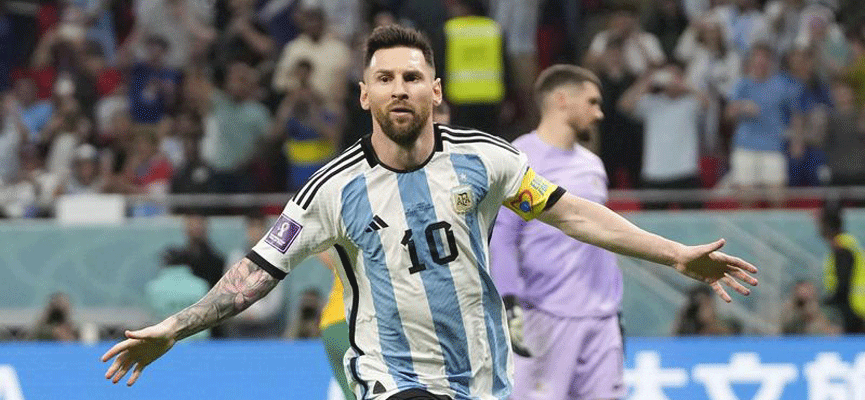In 2018, David Beckham expressed his belief that Miami needed a star player for his newly established Major League Soccer (MLS) franchise. He stated that Miami’s expectations were to bring in a prominent figure, and that was exactly what he intended to do.
Fast forward five years, and Inter Miami, co-owned by Beckham and brothers Jorge and Jose Mas, has delivered beyond expectations. They have secured the signing of none other than Lionel Messi, arguable the greatest player of all time and a World Cup winner.
Messi’s arrival in Miami has the potential to ignite a surge in soccer’s popularity in the United States, particularly in the three years leading up to the 2026 World Cup, which the country will co-host with Canada and Mexico.
Furthermore, the USA is set to host the 2024 Copa America, meaning Messi may have the opportunity to not only play his final club football game in the States but also participate in his last major international tournament.
These upcoming events mark significant milestones in Messi’s illustrious career, as he will be eligible to play his first game for Miami at the age of 36. However, their impact extends far beyond Messi himself, holding immense potential for the growth of soccer in the USA.
This move draws parallels to Beckham’s entry into MLS with LA Galaxy in 2007 and Pele’s venture to New York Cosmos in the 1970s, which generated considerable interest in American soccer at the time.
The extent of Messi’s influence will depend on whether his impact goes beyond superficial excitement. The crucial question remains: Will the enthusiasm and passion for the sport endure even after Messi’s departure, leading to a stronger domestic soccer landscape across the nation?
Currently, major North American men’s professional sports are dominated by the “Big Four” leagues: NBA, MLB, NFL, and NHL. MLS, while making strides, often takes a back seat and receives limited coverage in general sports discussions.
However, since Messi’s announcement, MLS has become a regular main story, impossible to overlook with the presence of the biggest name in global sports. The fact that this name belongs to a soccer player carries significant weight.
The anticipation surrounding Messi’s arrival is already evident, as Inter Miami’s social media following has surpassed that of many NHL, MLB, and NFL teams. Ticket sales for their games from July to the end of the season have seen a nearly 28-fold increase since Messi’s announcement.
Notably, tickets for Messi’s potential debut in the Leagues Cup against Cruz Azul are more expensive than those for the NBA Finals in Miami. Line-up announcements for the team now receive a flood of comments, with many asking eagerly, “Where’s Messi?”
While Messi’s presence will undoubtedly benefit MLS, the impact on soccer in America as a whole requires a broader perspective. It necessitates a stronger connection between leagues at different levels across the country, bridging the gap between MLS, the lower-tier USL, and beyond.
Moreover, the absence of promotion and relegation in American soccer presents a challenge. To ensure Messi’s impact transcends the league in which he plays, MLS may need to open up and consider other parallel soccer organizations while fostering grassroots development.
MLS has already demonstrated flexibility to attract Messi, with factors such as a new broadcast deal with Apple TV, shared partnerships with Adidas, and Beckham’s ownership of a club in Miami contributing to favorable circumstances.
It’s fitting that Beckham, whose arrival in MLS prompted the creation of the “designated player rule,” is now the owner facilitating Messi’s move. The details of Messi’s contract are yet to be disclosed, but it is expected to go beyond a standard designated player agreement, elevating the league’s offerings to new heights.
Similar to NBA star Michael Jordan’s groundbreaking deal with Nike in 1984, where he received a percentage of sales, Messi’s agreement with MLS and its partners will likely involve additional benefits. Rumors suggest he may secure a club ownership stake and potentially gain a percentage of sign-ups to Apple TV’s MLS Season Pass, among other ventures.
To compete with the lucrative offers from Saudi Arabia, MLS had to think outside the box. If Messi’s presence is to transcend the league and make a lasting impact on American soccer, MLS must also explore unconventional avenues outside of its established framework.
Nevertheless, expecting one player to single-handedly revolutionize the sport’s landscape in a vast and diverse region like the United States is an immense task. Soccer already holds a following in the country, but it often takes a backseat to other domestic and international competitions.
Fans in the US may fervently support the national team or European and Mexican clubs, but the structure of American club soccer on a national level lacks the mass intrigue and devotion found elsewhere. Pele and Beckham laid the groundwork, and now Messi will strive to build upon it.
Messi’s arrival will undoubtedly bring higher attendance, global attention, and increased awareness of MLS. However, for these effects to become permanent fixtures in American soccer, a strong foundation must be built at the local level, grounded in this monumental and magical move.
In summary, Lionel Messi’s entry into Miami marks a turning point for American soccer, with the potential to elevate the sport’s popularity to new heights. MLS must seize this opportunity to foster connections, engage with other soccer organizations, and build a sustainable future for the sport nationwide.

